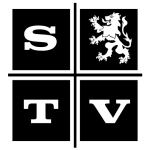Central Scotland

Scottish Television Limited is the public company which under agreement with the Independent Television Authority provides the programmes in Central Scotland during the whole week.
Theatre Royal, Hope Street, Glasgow C.2.
GLASGOW DOUGLAS 9999
Wingate House, 93 Shaftesbury Avenue, London W.1.
REGent 6941
Spencer House, Digbeth, Birmingham 5.
BIRMINGHAM MIDLAND 9303
Thomson House, Withy Grove, Manchester 4.
MANCHESTER BLACKFRIARS 7621
ITA Channel Vision Sound Opening Date Population ITA Homes
Transmitter Frequency Frequency 000's 000's
Mc/s Mc/s
Black Hill 10 199.7305 196.2395 31st Aug 1957 3,980 936
Directors
R Thompson (Chairman); JM Coltart (Deputy Chairman); Lord Balfour of Inchrye, PC; W Brown; JJ Hardy; CN McQueen; HNC Stevenson, OBE (Managing Director); IM Stewart; J Whitton.
Officers
RS Coltart (Administration Manager); H Henry (General Sales Manager); L Henry (Chief Accountant); D Kane (Technical Controller); G le Grove (Director of Programmes); JHB Munro (Secretary); TV Shields (Press and Publicity Manager); R McPherson (Head of Schools Broadcasts).
Staff
Total members of staff: 429. Administration 113, Accounts 26, Sales 51, Programme Department 96, Technical Facilities 110, Non-Technical Facilities 33.
Visits to Studios
An average of four hundred tickets are issued daily for the One O’Clock Gang Show, and to date well over a million visitors have been to see STV productions. Throughout the year audiences are also invited to see such programmes as Jigtime, At the Lucky Diamond, Studio Downbeat and Francie and Josie.
More than 1,500 new visitors are welcomed at the Theatre Royal every year when an average of seventy tours are arranged for members of organisations in Scotland to see over the Theatre Royal. Refreshments are served to visiting parties and an information pamphlet on the station’s activities is issued to each guest.
Enquiries
Enquiries about artistes and programmes should be addressed to the Director of Programmes, Scottish Television, Theatre Royal, Glasgow C.2.
Submission of Scripts
Material required. 30-60-minute plays in completed dialogue form, preferably contemporary and with some relevance, either of theme, setting or authorship, to Scotland. Adaptations from short stories or novels are rarely considered. Comedy sketch material for daily lunchtime shows may be submitted, although a local knowledge of the show and the cast is almost essential. Documentary ideas, particularly with a Scottish slant, considered, as are children’s items of the magazine type. No present demand for quiz games, panel shows, musicals, talks, short stories or poetry readings. All submissions should be addressed to the Script Editor.
Programme Journal
The Viewer publishes separate editions for the Newcastle and Central Scotland areas giving details of both local and network programmes. Editorial office for Scotland is Theatre Royal, Glasgow C.2.
Studios
THEATRE ROYAL, Hope Street, Glasgow. Total studio floor area 9,100 sq. ft.; Studio A 80′ × 50′ (4,000 sq. ft.), Studio B 38′ × 30′ (1,140 sq. ft.), Studio C 80′ × 45′ (3,600 sq. ft.), Studio D 12′ × 15′ (180 sq. ft.), Studio E 12′ × 15′ (180 sq. ft.). Control Rooms 1,500 sq. ft.; Technical Facilities Central Area approximately 4,000 sq. ft.; Workshop and Maintenance 2,500 sq. ft.; Rehearsal Area 1,200 sq. ft.; A three-camera mobile control room for outside broadcasts. Two videotape recorders.
Technical Developments
Scottish Television’s engineers have pioneered a revolutionary new new development for small television stations in underdeveloped territories – the one-man control centre. In this new design all the controls for operating a television service – video control, continuity, switching for sound and vision, cueing to announcer, operating tele-cine and changing slides – have been grouped to simplify co-ordination and assure smooth functioning, even in unskilled hands. Its designers claim any inexperienced person can operate it confidently after only a few days’ instruction. The first production models were installed at Nairobi, Gibraltar and Trinidad – three stations all opened within weeks of each other in 1962.
Education
An Educational Advisory Committee serves both STV and Grampian Television. Delegates attend all meetings of A-R‘s Educational Advisory Council. The company is represented on the Study Group on teaching by television of the European Broadcasting Union. The education department maintains regular contact with schools and colleges and its members give talks to a wide variety of groups interested in education. At intervals, study groups of teachers are invited to the studios to confer on particular programme series.
Religion
Policy and planning meetings are held regularly with the company’s Religious Advisory Committee. Training courses for ministers are held from time to time at the Theatre Royal.
Programmes
STV production include: News and News Magazines: Here and Now, Dateline-Scotland. Talks, Discussions and Documentaries: Sense and Nonsense, This Wonderful World. Cultural: Highland Air, Studio C, The Scottish National Orchestra. Religion: Seek the Truth, Church Services, Youth Discussions, Late Call. Children: Roundup. Schools: ten programmes each year covering a wide variety of subjects, eight of which go out on the network. Plays: contributions to the Thirty Minute Theatre productions. Light Entertainment: Studio Downbeat, The One O’Clock Gang, situation-comedy series. Sport: Scotsport. Features: national occasions including Burns’ Night, St. Andrew’s Day and Hogmanay. By-Elections. Outside Broadcasts: among those planned for 1963 are concerts by the Scottish National Orchestra. Experimental Programmes: a series of fifteen-minute programmes screened twice a week during early afternoon cover a variety of subjects, including the care and handling of pets. Adult Education Programmes: plans for this series include late-evening programmes in medical teaching, physics, mathematics and public administration.

